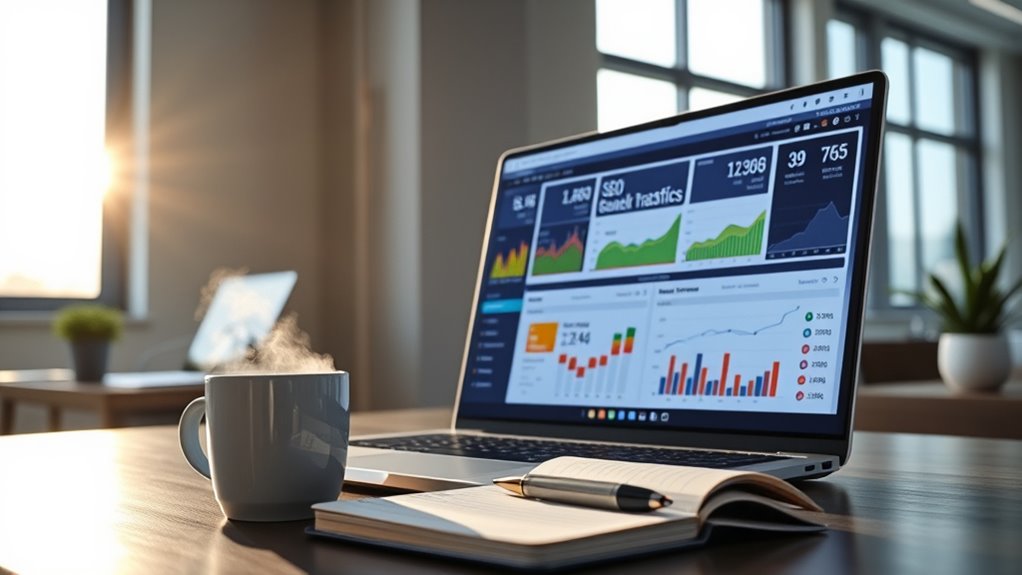To demonstrate organic value in 2025, focus on metrics beyond rankings, like user engagement, brand authority, and content relevance. Track how visitors interact with your content, monitor backlinks and trust signals, and measure content quality through dwell time and bounce rate. Technical health and community signals also play a role. By combining these diverse metrics, you’ll get a complete picture of your SEO success. Keep exploring to uncover how to apply these insights effectively.
Key Takeaways
- Focus on diversified metrics like brand authority, backlinks, and trust signals beyond traditional rankings to demonstrate overall SEO impact.
- Incorporate user engagement metrics such as dwell time, scroll depth, and bounce rate to measure content relevance and resonance.
- Use data visualization tools like dashboards and charts to communicate insights, trends, and progress effectively to stakeholders.
- Track community involvement, reviews, and social proof as indicators of organic authority and brand recognition.
- Regularly assess content quality, page speed, and technical health to ensure ongoing relevance and user satisfaction.
Moving Beyond Rankings: The New Metrics for Organic Success
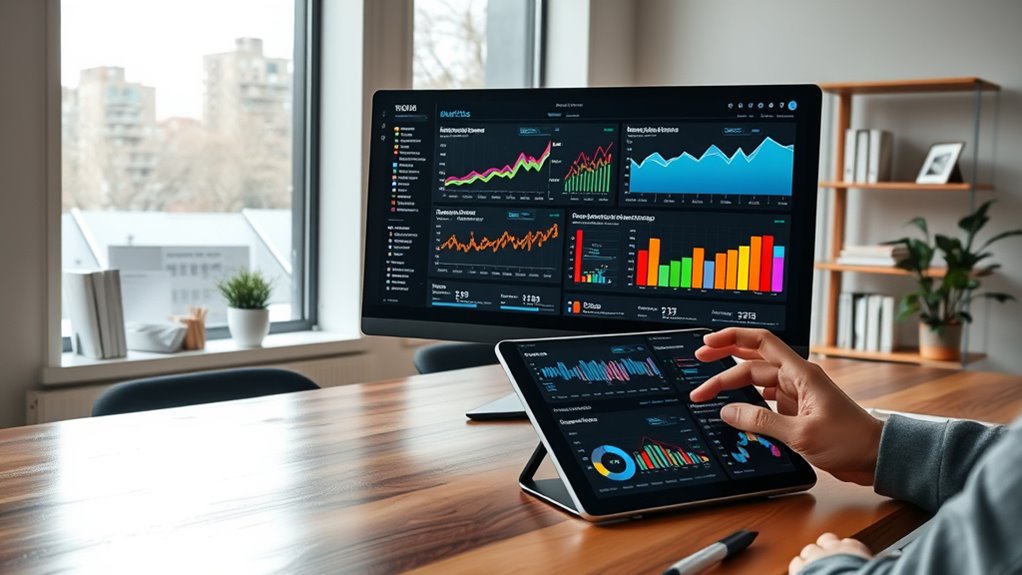
While rankings have traditionally been the primary measure of SEO success, they no longer tell the whole story. To truly gauge your organic growth, focus on metrics like keyword diversification, which shows how well your content ranks across various search terms, not just a single keyword. Equally important is backlink quality; high-quality backlinks from authoritative sites boost your site’s credibility and search visibility. Backlink quality can be a direct reflection of your content’s value and relevance. Understanding residency requirements in different regions can help you tailor your local SEO strategies effectively. Additionally, monitoring active listening and empathy can help refine your content strategy to better meet user needs and improve engagement. Developing authenticity in your content builds trust and strengthens your brand authority. Incorporating leadership skills into your content approach can also enhance your ability to connect with your audience and establish authority. These metrics give you a clearer picture of your SEO efforts’ effectiveness, helping you identify growth areas and refine strategies for sustained organic success in 2025.
User Engagement as a Key Indicator of Content Effectiveness

User engagement metrics like trend patterns, interaction levels, and time spent on your pages reveal how well your content resonates. These indicators help you understand whether visitors find your content valuable or if adjustments are needed. Tracking these metrics offers a clearer picture of content effectiveness beyond just rankings. Additionally, understanding the operating hours of local stores can inform your content strategy by aligning with when your audience is most active or seeking information. Incorporating audience behavior analysis can further refine your approach to content optimization and engagement strategies. Monitoring nutritional value of juices can also provide insights into what health-related topics resonate most with your audience, helping tailor future content to their interests. Recognizing vetted Halloween products can help you develop seasonal content that appeals to specific customer segments during peak times. Moreover, integrating wall organization systems into your content can demonstrate practical home decor solutions that increase user engagement and provide additional value.
Engagement Rate Trends
Tracking engagement rate trends is essential because it offers direct insight into how your audience interacts with your content. By analyzing these patterns, you can identify shifts in user behavior and better understand what resonates. Engagement rate trends reveal whether your content maintains audience interest over time or if certain topics lose appeal. Monitoring these shifts helps you refine your content strategy, ensuring your efforts align with evolving engagement patterns. Recognizing changes in user behavior allows you to adapt quickly, optimizing for higher engagement and increased organic reach. Keeping a close eye on these trends provides a clear view of content effectiveness, guiding data-driven decisions that boost overall SEO performance. Staying proactive in tracking engagement trends ensures your content remains relevant and compelling. Additionally, understanding audience engagement metrics can help you tailor your content to meet audience preferences more effectively, especially as emerging sneaker culture trends and other popular topics influence user interactions. Being aware of content performance indicators enables marketers to adjust strategies promptly, enhancing overall effectiveness and ROI.
Content Interaction Metrics
Content interaction metrics serve as essential indicators of how effectively your content engages your audience. By analyzing interaction analytics, you gain insights into user behaviors like clicks, shares, comments, and scroll depth. These metrics reveal whether your content resonates and encourages active participation. High content engagement suggests you’re providing value, boosting organic visibility and reinforcing your SEO efforts. Tracking interaction analytics helps you identify which content types and topics generate the most user involvement. This data allows you to refine your strategy, optimize future content, and better meet your audience’s needs. Additionally, understanding how specific content like Honda Tuning guides user interest can enhance your overall SEO approach. Recognizing performance upgrades and their impact on user engagement can further refine your content strategy. Incorporating content personalization techniques can also improve user engagement by delivering more relevant content experiences. Moreover, analyzing content performance across different channels enables you to identify the most effective distribution methods. To deepen your insights, examining audience demographics can help tailor content to specific user groups. Ultimately, focusing on content interaction metrics provides a clearer picture of your content’s effectiveness, ensuring your SEO reporting accurately reflects user engagement and organic value in 2025.
Time on Page
Time on page is a vital metric that reveals how well your content captures and holds visitors’ attention. When your page loads quickly, thanks to good page speed, visitors are more likely to stay longer. Conversely, a high bounce rate often indicates that visitors leave too soon, reducing your time on page. To improve this metric, consider these actions:
- Optimize page speed by compressing images and minimizing scripts.
- Create engaging, relevant content that meets visitor expectations.
- Use clear calls-to-action to encourage deeper site exploration.
- Regularly analyze bounce rate alongside time on page to identify weak spots.
- Implement vertical storage solutions and multi-functional furniture to enhance content relevance and keep visitors engaged longer. Additionally, incorporating interactive media such as videos or slideshows can boost engagement levels. Understanding Volkswagen Tuning techniques can also provide fresh content angles that capture user interest longer.
Tracking these metrics helps you understand content effectiveness. A longer time on page generally signals better engagement, but always assess it alongside bounce rate for a thorough view of user engagement.
Brand Authority and Its Influence on Organic Visibility
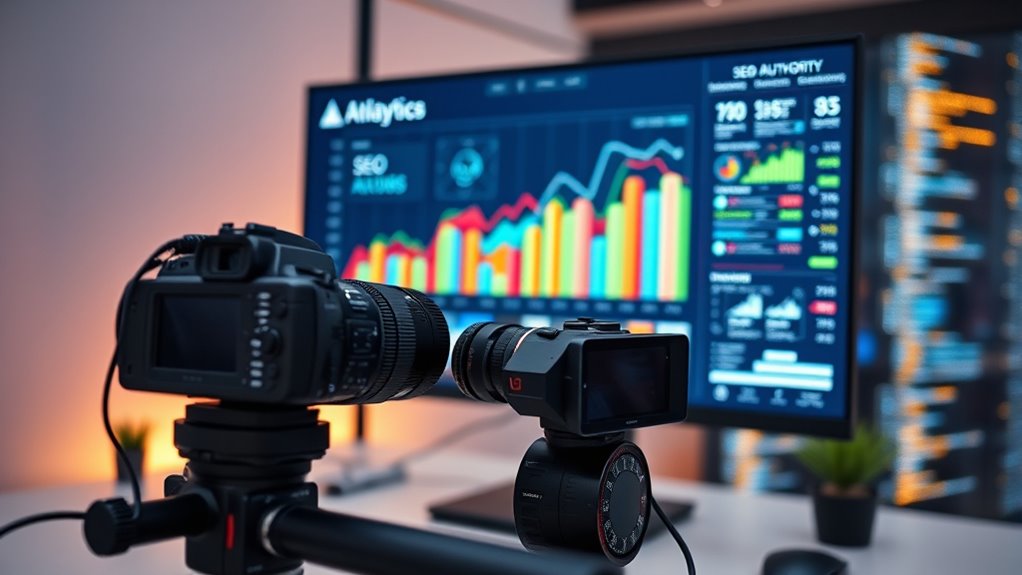
Your brand recognition plays a vital role in boosting organic visibility, making your site more trustworthy to both users and search engines. When your brand is seen as an authority, it signals quality through content signals and credibility factors. Strengthening your brand’s authority helps you rank higher and attract more engaged visitors. Incorporating consistent branding elements can also enhance self-watering plant pots recognition, further supporting your SEO efforts. Additionally, leveraging professional services can help craft a cohesive brand narrative that reinforces your authority across all digital channels. Building a strong brand presence also involves understanding how ethical hacking principles, such as continuous monitoring and vulnerability assessment, can be applied to maintain your site’s security and reputation, thereby enhancing overall credibility. Consistent branding efforts combined with a focus on security foster greater brand trust and improve your site’s organic performance.
Brand Recognition Impact
Have you ever wondered how brand recognition boosts your website’s visibility? When your brand has high awareness, it becomes top-of-mind for users searching for related topics. This increases organic traffic and strengthens your presence in search results. Brand loyalty also plays a pivotal role, as loyal customers are more likely to share your content and link to your site, improving your rankings. To maximize this impact, focus on:
- Building consistent brand messaging across channels
- Engaging audiences to enhance brand awareness
- Encouraging customer reviews to boost trust and recognition
- Creating memorable content that reinforces brand identity
Authority and Trustworthiness
When your brand gains authority and trustworthiness, it markedly enhances your organic visibility. Higher brand credibility signals to search engines that your site is reliable, boosting rankings. Trust signals like positive reviews, backlinks from reputable sources, and consistent NAP information build this trust. These elements influence how search engines perceive your authority, making your site more prominent in search results. Consider this table to see how trust signals impact your brand credibility:
| Trust Signal | Impact on Authority | Effect on Visibility |
|---|---|---|
| Positive reviews | Reinforces credibility | Improves rankings |
| Reputable backlinks | Validates trustworthiness | Boosts organic traffic |
| Consistent NAP info | Ensures reliability | Enhances local search presence |
| Media mentions | Builds brand authority | Increases organic reach |
| Social proof | Demonstrates popularity | Elevates search rankings |
Focusing on these trust signals strengthens your authority, directly influencing your organic visibility.
Content Quality Signals
Content quality signals play a crucial role in establishing and boosting your brand’s authority, which directly impacts your organic visibility. High-quality content demonstrates expertise, trustworthiness, and relevance, all essential for search engines. To improve these signals, focus on:
- Maintaining content freshness by regularly updating your content to reflect the latest information.
- Enhancing readability scores to ensure your audience can easily understand and engage with your material.
- Creating in-depth, well-structured articles that cover topics thoroughly.
- Monitoring content engagement metrics to gauge how your audience interacts with your content and adjust accordingly.
Content Quality and Relevance Metrics in 2025
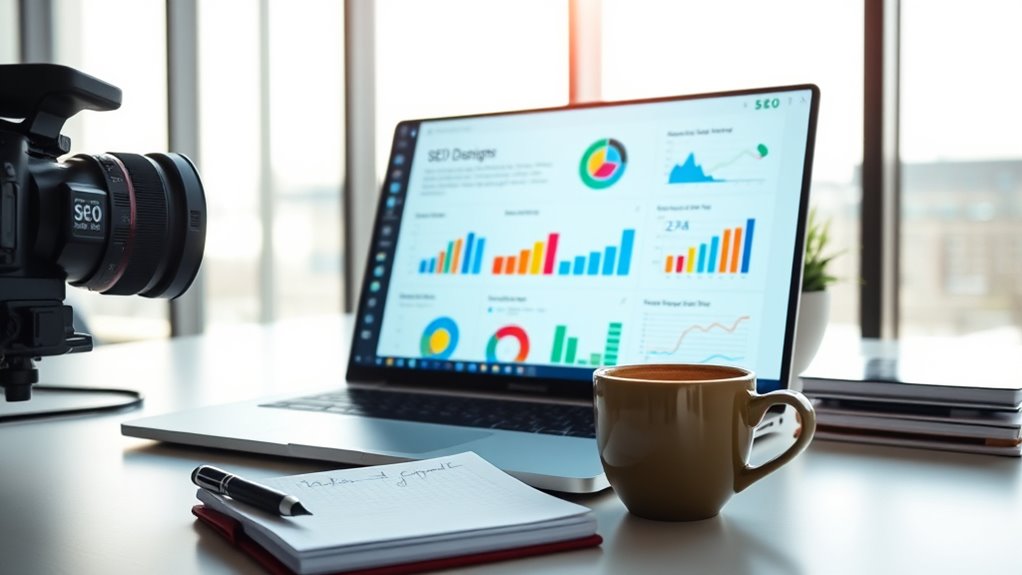
As search engines continue to prioritize user intent and experience, content quality and relevance metrics in 2025 have become more sophisticated and essential to SEO strategies. You now need to focus on content relevance, ensuring your material directly addresses your audience’s needs and search intent. Keyword optimization remains fundamental but goes beyond keyword stuffing; it involves natural integration that enhances content clarity. Metrics like dwell time, scroll depth, and bounce rate measure how well your content engages users and meets their expectations. Additionally, semantic relevance and contextual matching are crucial, signaling to search engines that your content aligns closely with user queries. By refining your focus on these metrics, you can better demonstrate the true value of your organic efforts in today’s competitive landscape.
Technical SEO Health and Its Impact on Search Performance

Maintaining a healthy technical SEO foundation is essential because it directly influences your website’s search performance. When technical issues arise, such as crawl errors or slow site speed, your visibility drops. To stay ahead, focus on these key areas:
A strong technical SEO foundation boosts search visibility and user experience.
- Regularly audit for crawl errors to ensure search engines can index your content effectively.
- Optimize site speed by compressing images and leveraging browser caching.
- Check for broken links and fix them promptly to improve user experience and crawl efficiency.
- Ensure your website has a mobile-friendly design to enhance accessibility and ranking signals.
Conversion-Driven Metrics for Organic Campaigns

To gauge the success of your organic campaigns, focusing on conversion-driven metrics is essential. These metrics reveal how well your efforts turn visitors into customers. Start by analyzing keyword intent to make certain your content aligns with what users seek, increasing the likelihood of conversions. Tracking bounce rates and time on page helps identify if your content meets user expectations. Additionally, evaluate backlink quality—high-quality backlinks signal authority and can boost your rankings, driving more targeted traffic. Conversion rates from organic search show the direct impact of your SEO strategies. By combining these metrics, you gain a clear picture of how effectively your organic campaigns generate value, enabling you to refine your approach and prioritize tactics that deliver measurable results.
Customer Journey Tracking and Attribution Models

Understanding the customer journey is essential for accurately measuring your organic campaign’s impact. To do this effectively, you need to focus on customer segmentation and attribution modeling. Segment your audience based on behaviors, interests, and touchpoints to gain clearer insights. Use attribution models to assign credit accurately across channels, revealing which touchpoints drive conversions. Consider these key steps:
Understanding the customer journey through segmentation and attribution enhances organic campaign insights and success.
- Map out the entire customer journey to identify critical touchpoints.
- Apply attribution modeling to evaluate the influence of each interaction.
- Analyze customer segments to understand different paths and preferences.
- Use insights from tracking to optimize your content and improve organic performance.
Social and Community Signals as Organic Strength Indicators
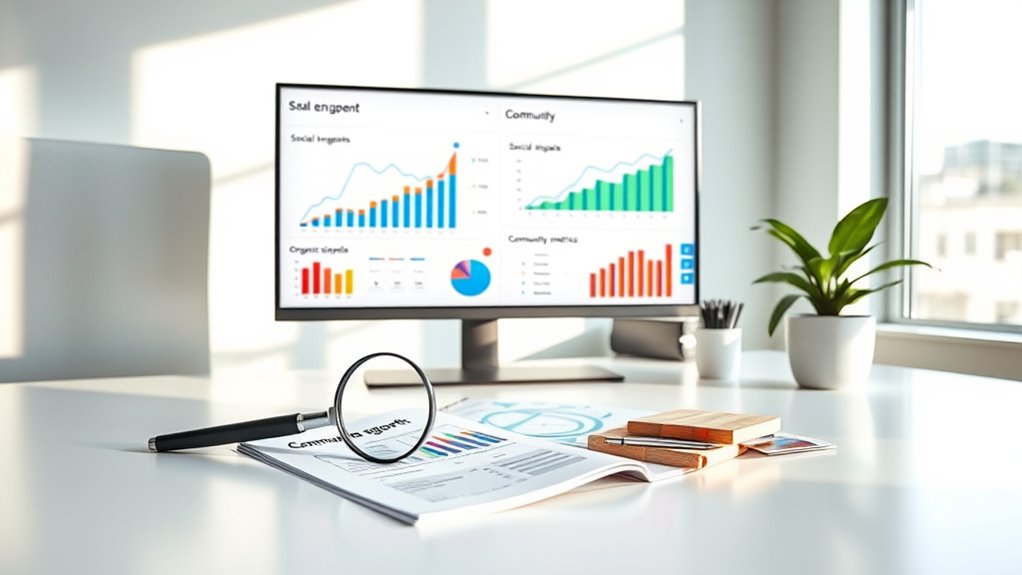
Social and community signals play a significant role in shaping your website’s organic strength. These signals, like shares, comments, and likes, directly influence search engine perception of your content’s relevance and authority. Strong community engagement indicates your content resonates with your audience, boosting trust and visibility. Tracking these metrics helps you understand how social signals contribute to your overall SEO performance. Here’s a quick overview:
| Signal Type | Description | Impact on SEO |
|---|---|---|
| Shares | Content shared across platforms | Increases reach and backlinks |
| Comments | User interactions and feedback | Signals content relevance |
| Likes/Reactions | Positive user responses | Enhances credibility |
| Mentions | Brand or content mentions | Builds authority |
| Community Activity | Engagement within groups or forums | Strengthens overall signals |
Prioritize community engagement to amplify your organic strength.
Leveraging Data Visualization for Holistic SEO Insights
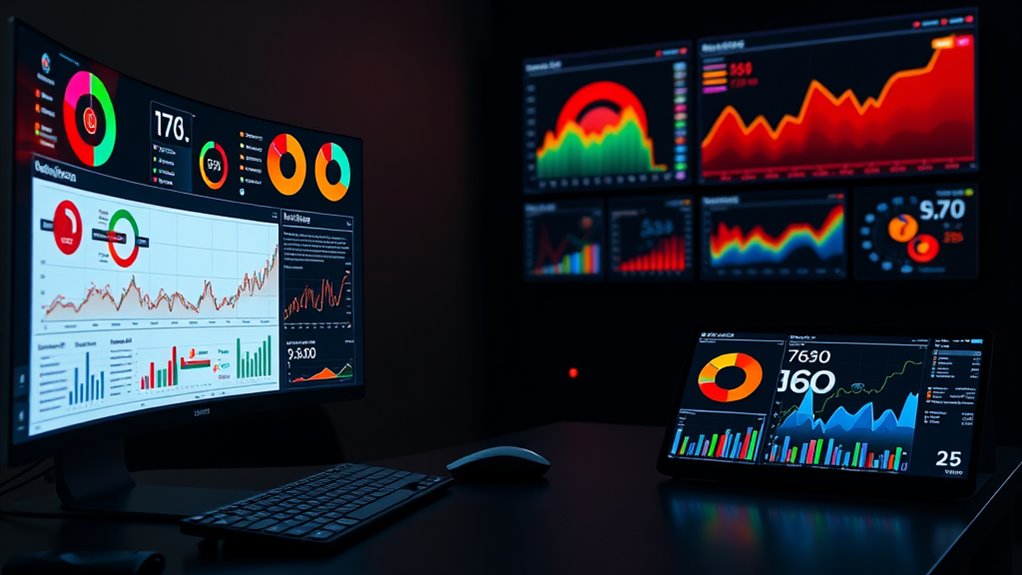
Data visualization transforms complex SEO data into clear, actionable insights that guide your strategy. By leveraging visual analytics, you can identify patterns and trends that might otherwise go unnoticed. This enhances your data storytelling, making it easier to communicate your organic performance to stakeholders. To maximize these benefits, focus on:
- Using interactive dashboards that allow real-time exploration of metrics
- Combining charts and graphs to illustrate correlation between SEO efforts and results
- Highlighting key KPIs to track progress across channels
- Employing color coding to quickly differentiate performance levels
These techniques help you create a holistic view of your SEO landscape, ensuring data-driven decisions that prove organic value effectively in 2025.
Frequently Asked Questions
How Can Small Businesses Effectively Measure SEO Success in 2025?
You can effectively measure SEO success by focusing on content quality and user engagement. Track how well your content resonates with your audience through metrics like bounce rate, time on page, and social shares. Use these insights to refine your strategies, ensuring your content remains relevant and engaging. This approach helps you demonstrate organic value clearly, making it easier to justify your SEO efforts and drive continuous improvement in 2025.
What Tools Are Best for Integrating Holistic SEO Metrics?
This is the most vital question you’ll ask this year! To effectively integrate holistic SEO metrics, you need tools that excel in content integration and data visualization. Google Data Studio, SEMrush, and Ahrefs offer robust features for combining data sources and creating clear visuals. These tools help you see the full picture, proving your organic efforts’ value, and making strategic decisions easier and more impactful.
How Does AI Influence Future SEO Reporting Strategies?
AI influences future SEO reporting strategies by enabling AI automation and predictive analytics, which help you analyze large data sets quickly and accurately. You can identify trends, forecast performance, and adjust your strategies proactively. This technology allows you to focus on high-impact activities, improve decision-making, and demonstrate organic value more effectively, ensuring your SEO efforts stay ahead in a competitive landscape.
Are There Specific Metrics to Assess International SEO Performance?
Think of evaluating international SEO performance like charting a diverse map. You should track localized rankings to see how your site performs in specific countries, and monitor international keyword volume to understand global search demand. These metrics reveal where your efforts succeed or need adjustment, helping you optimize content for different regions. By focusing on these, you gain a clear picture of your international SEO impact, guiding smarter, targeted strategies.
How Can Brands Align SEO Metrics With Overall Marketing Goals?
To align SEO metrics with your overall marketing goals, focus on content alignment and goal integration. You should track KPIs that reflect both organic performance and broader marketing objectives, like conversions, engagement, and brand awareness. Regularly review these metrics to guarantee your SEO efforts support your company’s strategic priorities, making adjustments as needed. This approach helps demonstrate SEO’s value as a key driver in your marketing success.
Conclusion
By embracing these holistic SEO metrics, you’re painting a complete picture of your organic success—like assembling a puzzle where every piece matters. Moving beyond rankings, focus on user engagement, brand authority, and content quality to truly prove your value in 2025. When you track the customer journey and leverage data visualization, you turn raw data into a powerful story that guides your strategy forward. Stay adaptable, and your organic growth will flourish like a well-tended garden.
